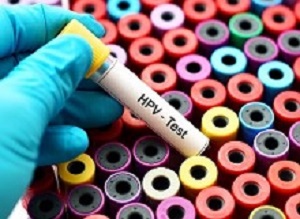 Screening for high risk human papillomavirus (HR-HPV) infection works well in practice and is more sensitive than cytology (smear) testing – offering greater protection against cervical cancer, confirm researchers. Their findings therefore support a switch to HPV screening across England and provide reassurance that screening intervals could be safely extended to at least five years, without increasing the risk of potentially life-threatening disease.
Screening for high risk human papillomavirus (HR-HPV) infection works well in practice and is more sensitive than cytology (smear) testing – offering greater protection against cervical cancer, confirm researchers. Their findings therefore support a switch to HPV screening across England and provide reassurance that screening intervals could be safely extended to at least five years, without increasing the risk of potentially life-threatening disease.
At present, 2,500 cases of cervical cancer are diagnosed each year in England, with a quarter diagnosed after a “normal” smear test result. Clinical trials show that HR-HPV screening leads to earlier detection of cervical lesions (known as cervical intraepithelial neoplasia or CIN) than liquid-based cytology or LBC (“smear”) testing.
As such, NHS England and Public Health England are working towards a national roll-out of HPV screening by the end of 2019.
To ensure these trial results would work in the “real world” a large pilot study of routine HPV and LBC testing was carried out in six NHS laboratories across England. A team of UK researchers analysed results from this pilot, which included 578,547 women aged 24-64 years undergoing routine cervical screening (32% HR-HPV; 68% LBC) between May 2013 and December 2014, who were followed up until May 2017.
Women were immediately referred for further testing (colposcopy) if their HR-HPV test was positive and cervical lesions were found.
HR-HPV positive women with no cervical lesions were asked to return in 12 months for another test (early recall), and if HR-HPV persisted without abnormal cells, were recalled again at 24 months. Reassuringly, 80% of women attended these early recall appointments.
After taking account of factors that might have affected the results, the researchers compared levels of cervical lesions (CIN) picked up by the two screening tests.
CIN is divided into grades: CIN1, 2+ or 3+. The higher the number, the more of the cervix is affected.
They found that HR-HPV screening detected substantially more CIN than LBC testing (50% more CIN2+, 40% more CIN3+ and 30% more cervical cancer). What’s more, a quarter of the CIN2+ was detected after early recall in women with no cervical lesions.
The increased sensitivity of HR-HPV screening is also reflected in the remarkably low detection of CIN2+ amongst HR-HPV negative women when rescreened at three years, compared with LBC negative women, they add.
This is an observational study, and the researchers can’t rule out the possibility that some of their findings may be due to other unmeasured (confounding) factors. Nevertheless, they say this large pilot carried out under routine screening conditions has confirmed that HR-HPV screening is practical on a large scale – and confers greater sensitivity for both CIN3+ and cervical cancer than LBC testing.
In addition, this increased detection in prevalence (existing cases) was followed by a marked reduction in incidence (new cases) after three years, “lending strong support to an extension of the screening intervals,” they conclude.
Abstract
Objective: To provide the first report on the main outcomes from the prevalence and incidence rounds of a large pilot of routine primary high risk human papillomavirus (hrHPV) testing in England, compared with contemporaneous primary liquid based cytology screening.
Design: Observational study.
Setting: The English Cervical Screening Programme.
Participants: 578 547 women undergoing cervical screening in primary care between May 2013 and December 2014, with follow-up until May 2017; 183 970 (32%) were screened with hrHPV testing.
Interventions: Routine cervical screening with hrHPV testing with liquid based cytology triage and two early recalls for women who were hrHPV positive and cytology negative, following the national screening age and interval recommendations.
Main outcome measures: Frequency of referral for a colposcopy; adherence to early recall; and relative detection of cervical intraepithelial neoplasia grade 2 or worse from hrHPV testing compared with liquid based cytology in two consecutive screening rounds.
Results: Baseline hrHPV testing and early recall required approximately 80% more colposcopies, (adjusted odds ratio 1.77, 95% confidence interval 1.73 to 1.82), but detected substantially more cervical intraepithelial neoplasia than liquid based cytology (1.49 for cervical intraepithelial neoplasia grade 2 or worse, 1.43 to 1.55; 1.44 for cervical intraepithelial neoplasia grade 3 or worse, 1.36 to 1.51) and for cervical cancer (1.27, 0.99 to 1.63). Attendance at early recall and colposcopy referral were 80% and 95%, respectively. At the incidence screen, the 33 506 women screened with hrHPV testing had substantially less cervical intraepithelial neoplasia grade 3 or worse than the 77 017 women screened with liquid based cytology (0.14, 0.09 to 0.23).
Conclusions: In England, routine primary hrHPV screening increased the detection of cervical intraepithelial neoplasia grade 3 or worse and cervical cancer by approximately 40% and 30%, respectively, compared with liquid based cytology. The very low incidence of cervical intraepithelial neoplasia grade 3 or worse after three years supports extending the screening interval.
Authors
Matejka Rebolj, Janet Rimmer, Karin Denton, John Tidy, Christopher Mathews, Kay Ellis, John Smith, Chris Evans, Thomas Giles, Viki Frew, Xenia Tyler, Alexandra Sargent, Janet Parker, Miles Holbrook, Katherine Hunt, Penny Tidbury, Tanya Levine, David Smith, Julietta Patnick, Ruth Stubbs, Sue Moss, Henry Kitchener
[link url="https://www.bmj.com/company/newsroom/study-strongly-supports-extending-cervical-screening-intervals/"]BMJ material[/link]
[link url="https://www.bmj.com/content/364/bmj.l240"]BMJ abstract[/link]
